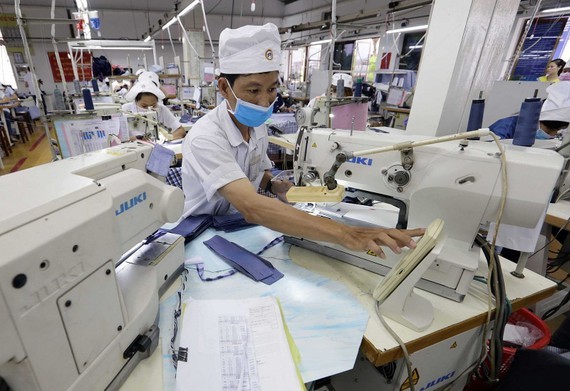 In the first six months of this year, besides the impact of the Covid-19 pandemic, enterprises in Vietnam have to carry additional production costs because raw material prices, transportation costs, and land rents climbed. (Photo: SGGP)
In the first six months of this year, besides the impact of the Covid-19 pandemic, enterprises in Vietnam have to carry additional production costs because raw material prices, transportation costs, and land rents climbed. (Photo: SGGP)
At the seminar held on the afternoon of July 21 in Hanoi, Vietnam's macroeconomic report for the second quarter and the first six months of this year was released by a research team of the VEPR.
According to the report, Vietnam's economy grew by 6.61 percent in the second quarter of this year. Agriculture, forestry, fishery, industry, construction, and services all increased in the first six months of the year. The FDI sector continues to be the main contributor to growth through exports.
However, in the first six months of this year, besides the impact of the Covid-19 pandemic, enterprises in Vietnam have to carry additional production costs because raw material prices, transportation costs, and land rents climbed. The trade balance was in deficit due to the demand to import raw materials to restore the production of enterprises. Interbank interest rates have unexpectedly surged again since February.
Noticeably, in the first six months of this year, 70,200 enterprises suspended operations for a definite time, ceased operations to wait for dissolution procedures, and completed dissolution procedures, an increase of 24.9 percent over the same period last year.
Forecasting the economic outlook for 2021, VEPR lowered its growth forecast to 4.5-5.1 percent, 1.2 to 1.5 percentage points lower than the previous forecast.
The economic outlook in the last months of the year largely depends on the speed and scale of vaccination, effectiveness, side effects of prevention measures, support packages, and growth stimulus packages in the country, according to the report.
The VEPR research team presented three growth scenarios.
Base scenario: The pandemic is controlled by the end of the third quarter of this year. Vaccination is deployed quickly, and herd immunity is achieved in the second quarter of 2022. The macro-economy remains stable. Economic growth for the whole year is forecasted at 4.5-5.1 percent.
Favorable scenario: The pandemic is controlled in August 2021. Vaccination is accelerated, and herd immunity is achieved in the first quarter of 2022. The macro-economy remains stable. Economic growth for the whole year is forecasted at 5.4–6.1 percent.
Adverse scenario: The pandemic cannot be controlled, and economic activities cannot return to normal until the fourth quarter. The vaccination process is implemented slowly due to a lack of supply. Policies to support people and enterprises and the process of restructuring and digital transformation are promoted, but services, trade, and FDI attraction recover slowly. At that time, Vietnam's economy can only grow from 3.5-4 percent in 2021.
According to the report, Vietnam's economy grew by 6.61 percent in the second quarter of this year. Agriculture, forestry, fishery, industry, construction, and services all increased in the first six months of the year. The FDI sector continues to be the main contributor to growth through exports.
However, in the first six months of this year, besides the impact of the Covid-19 pandemic, enterprises in Vietnam have to carry additional production costs because raw material prices, transportation costs, and land rents climbed. The trade balance was in deficit due to the demand to import raw materials to restore the production of enterprises. Interbank interest rates have unexpectedly surged again since February.
Noticeably, in the first six months of this year, 70,200 enterprises suspended operations for a definite time, ceased operations to wait for dissolution procedures, and completed dissolution procedures, an increase of 24.9 percent over the same period last year.
Forecasting the economic outlook for 2021, VEPR lowered its growth forecast to 4.5-5.1 percent, 1.2 to 1.5 percentage points lower than the previous forecast.
The economic outlook in the last months of the year largely depends on the speed and scale of vaccination, effectiveness, side effects of prevention measures, support packages, and growth stimulus packages in the country, according to the report.
The VEPR research team presented three growth scenarios.
Base scenario: The pandemic is controlled by the end of the third quarter of this year. Vaccination is deployed quickly, and herd immunity is achieved in the second quarter of 2022. The macro-economy remains stable. Economic growth for the whole year is forecasted at 4.5-5.1 percent.
Favorable scenario: The pandemic is controlled in August 2021. Vaccination is accelerated, and herd immunity is achieved in the first quarter of 2022. The macro-economy remains stable. Economic growth for the whole year is forecasted at 5.4–6.1 percent.
Adverse scenario: The pandemic cannot be controlled, and economic activities cannot return to normal until the fourth quarter. The vaccination process is implemented slowly due to a lack of supply. Policies to support people and enterprises and the process of restructuring and digital transformation are promoted, but services, trade, and FDI attraction recover slowly. At that time, Vietnam's economy can only grow from 3.5-4 percent in 2021.
























